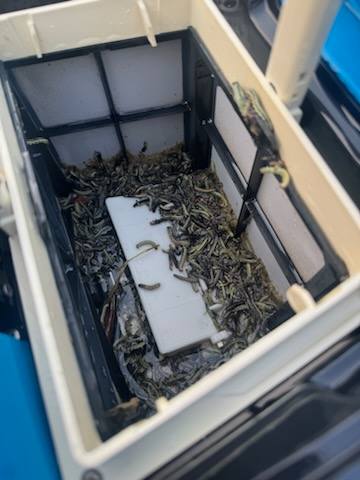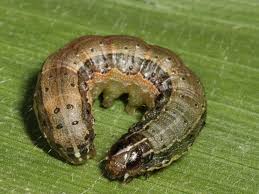This year, some unlucky Northwest Arkansas homeowners are waking up to find their yard is being invaded by hundreds of caterpillars. If you’ve lived in the American south for a while, you may have heard of Armyworms, or “Fall Armyworms”. Both terms refer to the larvae of several species of moth, so named because they are known to descend on lawns, agricultural sites, and undergrowth like an army on the march. Unfortunately, based on Natural State Pest Control’s correspondence with the community, it’s clear that this force is on the move, and your lawn may be their next stop.

*Image taken by John Wells, one of our salesmen, when he visited a property last week. That's dozens of armyworms inside of a pool filter right here in Northwest Arkansas!
Fall Armyworms are native to Northwest Arkansas and most of our neighboring states. They are extremely susceptible to the cold, so they don’t usually amass this far north, with most populations in the US only surviving the winter at the southernmost tip of Texas. When conditions are right and the winters are mild, though, they can come farther north in large numbers. Their peak time of activity is in late summer and early fall. During this part of the season, the eggs will hatch and the armyworm larvae descend on foliage wherever they can find it, whether that’s cropland or common grasses like bermudagrass or fescue (bluegrass).
There are plenty of pests that feed on greenery, but the armyworm is especially troubling for two reasons: their method and rate of consumption. When caterpillars eat from the end of the blade toward the root, most grasses are hardy enough to recover if enough of the blade is left behind once the caterpillar has moved on. Armyworms, on the other hand, begin eating at the stem, low on the plant. This means that munched-on grasses are unable to recover, resulting in prematurely dormant grasses and, in more serious cases, turf death. Worst still, is the way that their consumption of plant material ratchets up over time. The first few stages of larval growth don’t require the armyworms to eat much, so it’s easy to miss the damage they’re doing. By the time farmers or homeowners notice browning grass (which is usually misdiagnosed as heat stress), the armyworms have moved to stages of development that are much more destructive. Unfortunately the old adage is true: this army really does march on it’s stomach.

Fortunately, Natural State Pest Control has just the thing for Fall Armyworms: our Yard Defense service. Though this service is for fleas, ticks, and mosquitos, customers who request treatment for Fall Armyworms will receive an effective treatment on their turf. We want to ensure that our customers can stop this threat before losing their lawns and other greenery. If you’ve woken up to a standing army of caterpillars treating your lawn like takeout, reach out to the team at Natural State at 479-777-0864.

